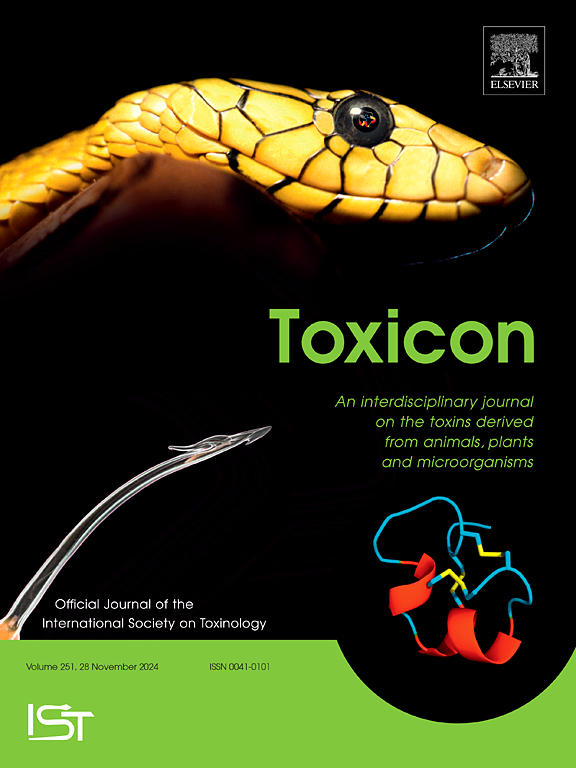实验净化后野生捕捞鱼组织中微囊藻毒素和蛤蚌毒素的持久性
IF 2.6
4区 医学
Q2 PHARMACOLOGY & PHARMACY
引用次数: 0
摘要
有毒蓝藻华在世界范围内发生,在华中经常发现肝毒性微囊藻毒素(MCYSTs)和神经毒性石笋毒素(STXs),两者都在淡水生物中表现出生物积累。在此,我们通过实验评估了来自墨西哥中部一个人源化水库的两种野外暴露鱼类(原生的Goodea atripinnis和引进的Oreochromis niloticus)肌肉和肝脏/内脏中MCYSTs和STXs的潜在净化和浓度动态,包括4个净化事件:8、16、24和32天。尽管实验结束时,豚鼠内脏中这两种蓝藻毒素的浓度略有下降,但在所有分析的组织中,通过第四次净化事件仍然可以检测到两种物种的MCYSTs和STXs。此外,对于O. niloticus,肝脏中MCYSTs和STXs的浓度在第一次和第四次净化事件中增加,可能与在生物体完全消除之前肝细胞对毒素的摄取和释放循环有关,这可以在未来的研究中进行特异性测试。我们的研究增加了蓝藻毒素在实验净化过程后长期存在的证据,甚至发现在净化过程中,如果食用鱼类,MCYSTs的增加代表更高的风险,限制了该过程的效用,以减少人类食用受污染的鱼类产品所暴露的蓝藻毒素。本研究首次报道了MCYSTs和STXs同时在鱼类组织中长期存在,我们的研究结果表明,蓝藻毒素的净化似乎是一个物种和组织依赖的过程。本文章由计算机程序翻译,如有差异,请以英文原文为准。

Persistence of microcystins and saxitoxins in tissues of wild-caught fish after an experimental depuration
Toxic cyanobacterial blooms are occurring worldwide with hepatotoxic microcystins (MCYSTs) and neurotoxic saxitoxins (STXs) frequently found together in blooms, both showing bioaccumulation in freshwater organisms. Here, we experimentally evaluated the potential depuration and concentration dynamics of MCYSTs and STXs in muscle and liver/viscera of two field exposed fish species from an anthropized reservoir in Central Mexico, Goodea atripinnis (native) and Oreochromis niloticus (the introduced Nile tilapia), during thirty-two days comprising four depuration events: 8, 16, 24 and 32 days. Despite some slight reduction in the concentrations of both cyanotoxins in the viscera of G. atripinnis at the end of the experiment, MCYSTs and STXs were still detected by the fourth depuration event in the two species in all tissues analyzed. Moreover, for O. niloticus, the concentrations of MCYSTs and STXs in liver increased by the first and fourth depuration events potentially associated with the uptake and release cycles of the toxin by hepatic cells before the complete elimination of the organism, which could be specifically tested in future studies. Our study adds evidence of a long-time persistence of cyanotoxins after an experimental depuration process, even finding an increase of MCYSTs during depuration representing a higher risk if fish are consumed, limiting the utility of this process in order to reduce the cyanotoxins exposure by humans consuming contaminated fish products. This study constitutes the first report of a long persistence of both MCYSTs and STXs simultaneously in fish tissues and our findings indicate that cyanotoxins depuration seems to be a species and tissue-dependent process.
求助全文
通过发布文献求助,成功后即可免费获取论文全文。
去求助
来源期刊

Toxicon
医学-毒理学
CiteScore
4.80
自引率
10.70%
发文量
358
审稿时长
68 days
期刊介绍:
Toxicon has an open access mirror Toxicon: X, sharing the same aims and scope, editorial team, submission system and rigorous peer review. An introductory offer Toxicon: X - full waiver of the Open Access fee.
Toxicon''s "aims and scope" are to publish:
-articles containing the results of original research on problems related to toxins derived from animals, plants and microorganisms
-papers on novel findings related to the chemical, pharmacological, toxicological, and immunological properties of natural toxins
-molecular biological studies of toxins and other genes from poisonous and venomous organisms that advance understanding of the role or function of toxins
-clinical observations on poisoning and envenoming where a new therapeutic principle has been proposed or a decidedly superior clinical result has been obtained.
-material on the use of toxins as tools in studying biological processes and material on subjects related to venom and antivenom problems.
-articles on the translational application of toxins, for example as drugs and insecticides
-epidemiological studies on envenoming or poisoning, so long as they highlight a previously unrecognised medical problem or provide insight into the prevention or medical treatment of envenoming or poisoning. Retrospective surveys of hospital records, especially those lacking species identification, will not be considered for publication. Properly designed prospective community-based surveys are strongly encouraged.
-articles describing well-known activities of venoms, such as antibacterial, anticancer, and analgesic activities of arachnid venoms, without any attempt to define the mechanism of action or purify the active component, will not be considered for publication in Toxicon.
-review articles on problems related to toxinology.
To encourage the exchange of ideas, sections of the journal may be devoted to Short Communications, Letters to the Editor and activities of the affiliated societies.
 求助内容:
求助内容: 应助结果提醒方式:
应助结果提醒方式:


